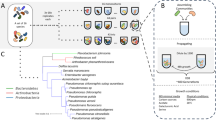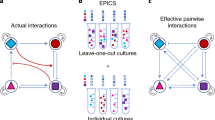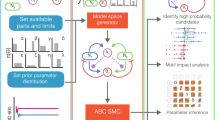Abstract
Microorganisms typically form diverse communities of interacting species, whose activities have tremendous impact on the plants, animals and humans they associate with. The ability to predict the structure of these complex communities is crucial to understanding and managing them. Here, we propose a simple, qualitative assembly rule that predicts community structure from the outcomes of competitions between small sets of species, and experimentally assess its predictive power using synthetic microbial communities composed of up to eight soil bacterial species. Nearly all competitions resulted in a unique, stable community, whose composition was independent of the initial species fractions. Survival in three-species competitions was predicted by the pairwise outcomes with an accuracy of ~90%. Obtaining a similar level of accuracy in competitions between sets of seven or all eight species required incorporating additional information regarding the outcomes of the three-species competitions. Our results demonstrate experimentally the ability of a simple bottom-up approach to predict community structure. Such an approach is key for anticipating the response of communities to changing environments, designing interventions to steer existing communities to more desirable states and, ultimately, rationally designing communities de novo.
This is a preview of subscription content, access via your institution
Access options
Access Nature and 54 other Nature Portfolio journals
Get Nature+, our best-value online-access subscription
$29.99 / 30 days
cancel any time
Subscribe to this journal
Receive 12 digital issues and online access to articles
$119.00 per year
only $9.92 per issue
Buy this article
- Purchase on Springer Link
- Instant access to full article PDF
Prices may be subject to local taxes which are calculated during checkout





Similar content being viewed by others
References
Falkowski, P., Fenchel, T. & Delong, E. The microbial engines that drive Earth’s biogeochemical cycles. Science 320, 1034–1039 (2008).
Berendsen, R. L., Pieterse, C. M. & Bakker, P. A. The rhizosphere microbiome and plant health. Trends Plant Sci. 17, 478–486 (2012).
Flint, H. J., Scott, K. P., Louis, P. & Duncan, S. H. The role of the gut microbiota in nutrition and health. Nat. Rev. Gastroenterol. Hepatol. 9, 577–589 (2012).
Matsuoka, K. & Kanai, T. The gut microbiota and inflammatory bowel disease. Semin. Immunopathol. 37, 47–55 (2015).
Widder, S. et al. Challenges in microbial ecology: building predictive understanding of community function and dynamics. ISME J. 10, 2557–2568 (2016).
Großkopf, T. & Soyer, O. S. Synthetic microbial communities. Curr. Opin. Microbiol. 18, 72–77 (2014).
Fredrickson, J. K. Ecological communities by design. Science 348, 1425–1427 (2015).
Faust, K. & Raes, J. Microbial interactions: from networks to models. Nat. Rev. Microbiol. 10, 538–550 (2012).
Bucci, V. & Xavier, J. B. Towards predictive models of the human gut microbiome. J. Mol. Biol. 426, 3907–3916 (2014).
Berry, D. & Widder, S. Deciphering microbial interactions and detecting keystone species with co-occurrence networks. Front. Microbiol. 5, 219 (2014).
Carrara, F., Giometto, A., Seymour, M., Rinaldo, A. & Altermatt, F. Inferring species interactions in ecological communities: a comparison of methods at different levels of complexity. Methods Ecol. Evol. 6, 895–906 (2015).
Billick, I. & Case, T. J. Higher order interactions in ecological communities: What are they and how can they be detected? Ecology 75, 1530–1543 (1994).
Momeni, B. & Shou, W. The validity of pairwise models in predicting community dynamics. Preprint at bioRxiv http://doi.org/10.1101/060988 (2016).
Wootton, J. T. The nature and consequences of indirect effects in ecological communities. Annu. Rev. Ecol. Syst. 25, 443–466 (1994).
Kelsic, E. D., Zhao, J., Vetsigian, K. & Kishony, R. Counteraction of antibiotic production and degradation stabilizes microbial communities. Nature 521, 516–519 (2015).
Stein, R. R. et al. Ecological modeling from time-series inference: insight into dynamics and stability of intestinal microbiota. PLoS Comput. Biol. 9, e1003388 (2013).
Bucci, V. et al. MDSINE: Microbial Dynamical Systems INference Engine for microbiome time-series analyses. Genome Biol. 17, 121 (2016).
Vandermeer, J. H. The competitive structure of communities: an experimental approach with protozoa. Ecology 50, 362–371 (1969).
Dormann, C. F. & Roxburgh, S. H. Experimental evidence rejects pairwise modelling approach to coexistence in plant communities. Proc. R. Soc. B 272, 1279–1285 (2005).
Mounier, J. et al. Microbial interactions within a cheese microbial community. Appl. Environ. Microbiol. 74, 172–181 (2008).
Fisher, C. K. & Mehta, P. Identifying keystone species in the human gut microbiome from metagenomic timeseries using sparse linear regression. PLoS ONE 9, e102451 (2014).
Marino, S., Baxter, N. T., Huffnagle, G. B., Petrosino, J. F. & Schloss, P. D. Mathematical modeling of primary succession of murine intestinal microbiota. Proc. Natl Acad. Sci. USA 111, 439–444 (2014).
Case, T. J. & Bender, E. A. Testing for higher order interactions. Am. Nat. 118, 920–929 (1981).
Zeeman, M. L. Hopf bifurcations in competitive three-dimensional Lotka–Volterra systems. Dyn. Stab. Syst. 8, 189–216 (1993).
Celiker, H. & Gore, J. Clustering in community structure across replicate ecosystems following a long-term bacterial evolution experiment. Nat. Commun. 5, 4643 (2014).
Concepción-Acevedo, J., Weiss, H. N., Chaudhry, W. N. & Levin, B. R. Malthusian parameters as estimators of the fitness of microbes: a cautionary tale about the low side of high throughput. PLoS ONE 10, e0126915 (2015).
Fukami, T. Historical contingency in community assembly: integrating niches, species pools, and priority effects. Annu. Rev. Ecol. Evol. Syst. 46, 1–23 (2015).
Wright, E. S. & Vetsigian, K. H. Inhibitory interactions promote frequent bistability among competing bacteria. Nat. Commun. 7, 11274 (2016).
Armstrong, R. A. & McGehee, R. Competitive exclusion. Am. Nat. 115, 151–170 (1980).
Huisman, J. & Weissing, F. Biodiversity of plankton by species oscillations and chaos. Nature 402, 407–410 (1999).
Yurtsev, E. A., Conwill, A. & Gore, J. Oscillatory dynamics in a bacterial cross-protection mutualism. Proc. Natl Acad. Sci. USA 113, 6236–6241 (2016).
Kerr, B., Riley, M. A., Feldman, M. W. & Bohannan, B. J. Local dispersal promotes biodiversity in a real-life game of rock–paper–scissors. Nature 418, 171–174 (2002).
Allesina, S. & Levine, J. A competitive network theory of species diversity. Proc. Natl Acad. Sci. USA 108, 5638–5642 (2011).
Acknowledgements
We thank A. Perez-Escudero, N. Vega, E. Yurtsev and members of the Gore Laboratory for critical discussions and comments on the manuscript. This work was supported by the Defense Advanced Research Projects Agency’s Biological Robustness in Complex Settings programme, an National Institutes of Health New Innovator Award (NIH DP2), an National Science Foundation CAREER Award, a Sloan Research Fellowship, the Pew Scholars Program and the Allen Investigator Program.
Author information
Authors and Affiliations
Contributions
J.F. and J.G. designed the study. J.F. and L.M.H. performed the experiments and analysis. J.F., L.M.H. and J.G. wrote the manuscript.
Corresponding authors
Ethics declarations
Competing interests
The authors declare no competing financial interests.
Supplementary information
Supplementary Information
Supplementary Figures 1–8 and Supplementary Tables 1–3. (PDF 2112 kb)
Rights and permissions
About this article
Cite this article
Friedman, J., Higgins, L. & Gore, J. Community structure follows simple assembly rules in microbial microcosms. Nat Ecol Evol 1, 0109 (2017). https://doi.org/10.1038/s41559-017-0109
Received:
Accepted:
Published:
DOI: https://doi.org/10.1038/s41559-017-0109
This article is cited by
-
Serial cultures in invert emulsion and monophase systems for microbial community shaping and propagation
Microbial Cell Factories (2024)
-
Assessing microbiome population dynamics using wild-type isogenic standardized hybrid (WISH)-tags
Nature Microbiology (2024)
-
Bacterial quorum sensing orchestrates longitudinal interactions to shape microbiota assembly
Microbiome (2023)
-
Experimental community coalescence sheds light on microbial interactions in soil and restores impaired functions
Microbiome (2023)
-
Antibiotic-degrading resistance changes bacterial community structure via species-specific responses
The ISME Journal (2023)



